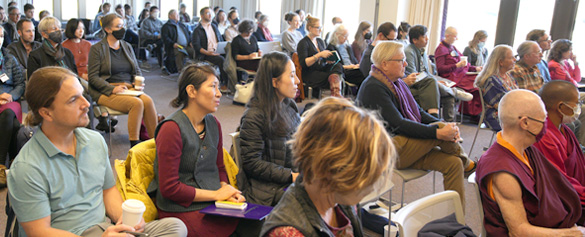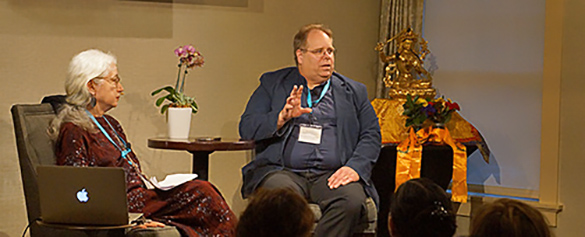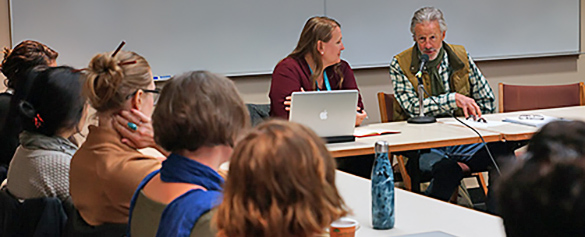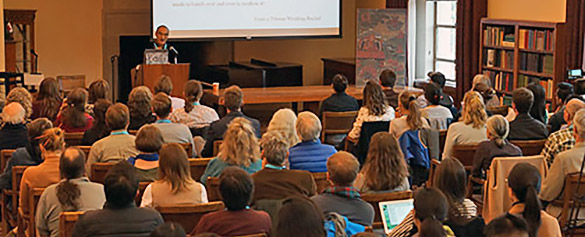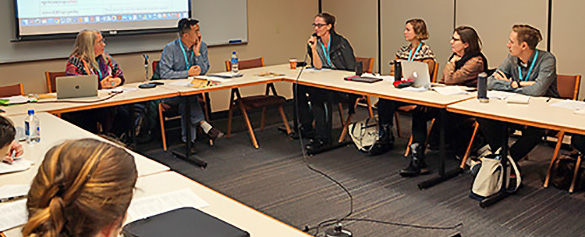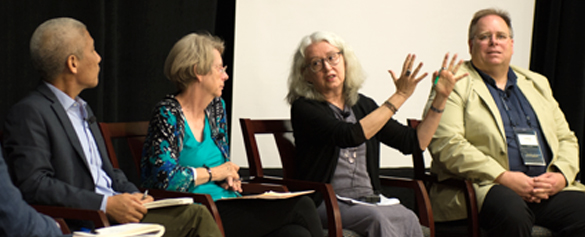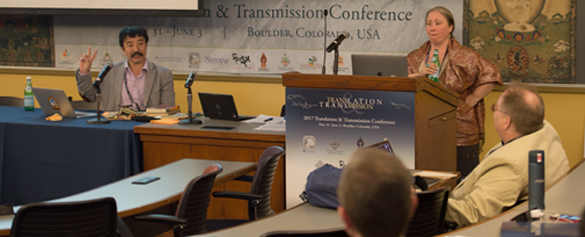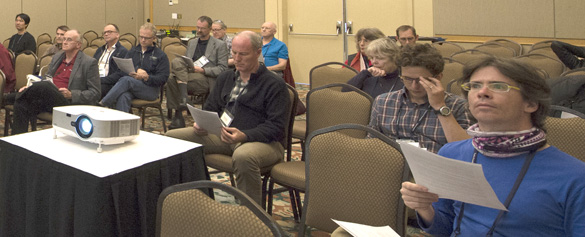The State of the Field
Migmar Lama2022-11-16T23:40:41-07:00Kurtis Schaeffer (University of Virginia) begins a reflective conversation about the State of the Field of Tibetan translation by acknowledging Janet Gyatso’s book Apparitions of the Self (1998). Kurtis notes that the work has fueled discussion about embodied engagement with literature that takes form and style in literature seriously. Since its release, it has inspired workshops and served as the basis of other significant work on the impact of thought, philosophy, and devotion on literary production.
The two scholars continue by contextualizing a major theme of current translation work: the fact that we can now focus on Tibetan literature as literature. […]
Criteria for Beauty and Readability
Migmar Lama2022-11-16T23:40:42-07:00When assessing the beauty and readability of a translation one might pose the following questions: does the text come alive in the target language? Is there a distinct emotional tone that comes through in the translation? Does a chosen grammatical structure have the power to convey what we are trying to convey? How do we summon that power to our work?
In this breakout group, Amelia Hall and Andrew Schelling, colleagues at Naropa University in Boulder, CO, address these questions and discuss the importance of techniques to invoke the power of the creative act of translation. They encourage the translator to […]
An Act of Bardo: Translating Tibetan Poetry
Migmar Lama2022-11-16T23:40:42-07:00Lama Jabb (Oxford) delivers this ground-breaking keynote lecture at the 2018 Lotsawa Translation Workshop. He weaves the extended metaphor of liminal space (bar do) throughout and softly punctuates his illumination of the translation process with insights from highly respected poets from numerous cultures while diligently considering the challenges and opportunities presented by the de- and reconstruction of languages. As he guides the audience through his translation choices, he explains his aims of preservation of cultural identity while delivering, with kindness, artistic richness to the reader. Ultimately questioning how translators can communicate in words that which is ineffable, Lama Jabb encourages […]
Collections of Songs (mgur ‘bum)
Migmar Lama2022-11-16T23:40:43-07:00By taking a bird’s-eye view of collections of songs (mgur ‘bum), Kurtis Schaeffer (University of Virginia) and Andrew Quintman (Wesleyan) examine gaps in our knowledge based on the extant collections and their experiences both as translators and as historians of literature. They elicit an exploratory discussion by beginning with a series of key questions and positing ways in which we can think about songs as an autonomous literary form as well as how we might approach the provenance of songs and the process of their production and reproduction from the standpoint of history, in addition to other stimulating topics. What […]
Ornamentation Shared by Poetry and Song
Migmar Lama2022-10-26T05:23:38-06:00With humor and levity, longtime collaborators Nicole Willock (Old Dominion) and Gedun Rabsal (Indiana) present chapter three of Daṇḍin’s Mirror of Poetics (Kāvyādarśa) through the lens of twentieth century Tibetan scholar Tseten Zhabdrung (the Snyan ngag spyi don). The focus is the concept of “world-play” (sgra rgyan) and the various examples given in this section of the text. Nicole outlines the third chapter and delves into the “richness of the phonemic value of poetry” with focus on beat, rhythm, and alliteration using examples from one section of the commentarial text focused on “phonemic reduplication” (zung ldan). Professor Rabsal looks at […]
Translating: What and How?
Marcus Perman2022-11-16T23:34:13-07:00On the second day of the conference, the nuts and bolts of the craft of translation became the focus and the main questions asked in this session were: What tools are in your translation workshop? What skills should one cultivate to be a good translator? How do we cultivate those skills? Elizabeth Napper begins the session by looking at the perennial issue of literal vs. aesthetic translation from a practical standpoint of needing to adjust to the intended audience of the translation. Thupten Jinpa continues this discussion of the tension between fidelity to the text and consideration of the reader […]
Kavya in Tibet
Marcus Perman2022-11-16T23:34:13-07:00Kavya in Tibet is a session following from a workshop on Tseten Zhabdrung’s commentary on poetics (Snyan ngag spyi don) that was hosted at the Latse Library with Gendun Rabsel, Nicole Willock, Andy Quintman, and Kurtis Schaeffer. The Tibetan system of poetics and ornate poetry is highly influential in the history of Tibetan writing and is based on the most important Indian manual of poetics, Daṇḍin’s Mirror of Poetics (Kāvyādarśa). This session introduced some of the fundamental theory and practice of this snyan ngag type of literature. The intellectual gravity of snyan ngag did not make itself felt until 1267 […]
Translating Poetic and Inspirational Materials
Marcus Perman2022-10-30T22:45:26-06:00Poetic and inspirational materials exist as a place where culture emerges creating a challenge for the translator to capture both the meaning and the psychological effect of the literature in the target language. Andrew Quintman begins this workshop with a theoretical discussion of how the characteristics and structure of a traditional song of devotion give clues about indigenous conceptions of poetry in the Tibetan tradition. Holly Gayley works through various grammatical structures and literary conventions, like metaphor and parallelism, to illustrate the scope of possibility in conveying meaning. Finally, Wulstan Fletcher guides the group through the challenge of capturing the […]


